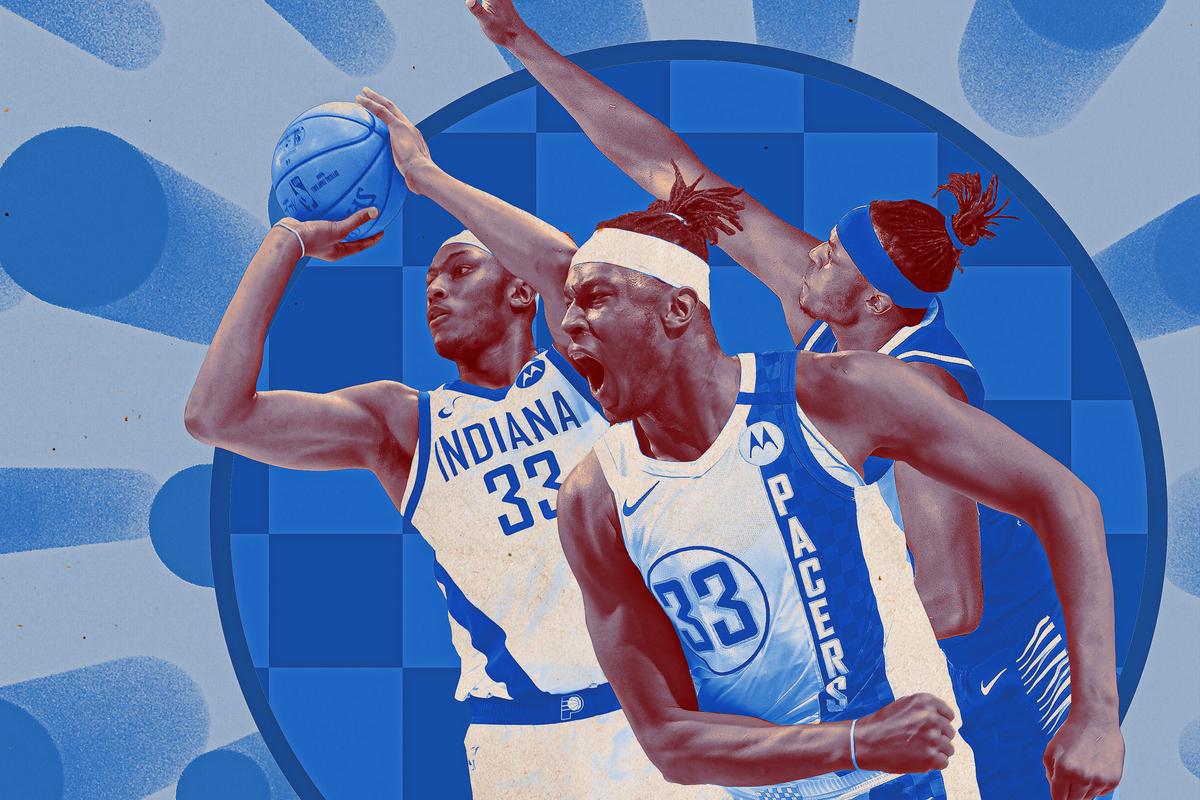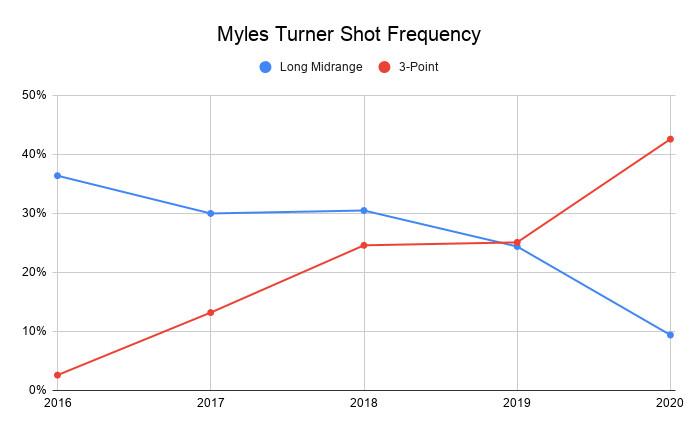
Myles Turner isn’t even the best center on his own team anymore. That much is clear after the 2019-20 season, when Domantas Sabonis elevated to an All-Star level while Turner suffered a sprained ankle early and never quite found his groove upon returning. If the Pacers actualize the long-held belief that they’d need to trade one of their bigs, Turner is now the only candidate to leave.
But despite this hierarchical reduction, Turner can still help a team in need of interior defense from a stretch big. He is a near-perfect embodiment of a modern positional trope. And as free agency begins and trade chaos reigns, with the start of the season just a month away, he could be the key to unlocking several teams with an eye on the title race.
Summarizing Turner’s appeal in one stat is surprisingly simple: In the 2018-19 season, Turner and Milwaukee’s Brook Lopez—whose prototypical growth into a stretch 5 coincided with the Bucks’ rise to the top of the East—were the only players with at least two blocks and one made 3-pointer per game. Last season, that group doubled in size, giving Turner mighty fine company:
- Turner
- Lopez
- Anthony Davis
- Kristaps Porzingis
Let’s start with the first of those criteria. Defense remains the most difficult part of the sport to measure with precision, but various available indicators point to Turner’s abilities on that end of the floor. Turner impresses with traditional stats; he led the league with 2.7 blocks per game in 2018-19. He impresses with shot data, allowing opponents to shoot just 51 percent near the basket last season, an elite mark. (For reference, Rudy Gobert was at 48 percent, Davis at 50.) And he impresses most of all with advanced stats, as ESPN’s real plus-minus and Jacob Goldstein’s player impact plus-minus both rate Turner among the league’s best defenders, worth around three points per 100 possessions.
Myles Turner’s Advanced Defensive Stats
Even if those numbers oversell Turner’s presence a bit, he’s clearly a stout defender, sufficiently springy to challenge shots at the rim and sufficiently fleet of foot to maintain tight pick-and-roll coverage. Many bigs with shooting range struggle to compete as well on the defensive end, but Turner can function as the lone big man in a lineup without its defense imploding.
The other half of Turner’s appeal is the ability to stretch the floor from the center position. Much like Lopez, Turner has transformed his shot selection to follow broader league patterns, taking metaphorical steps forward by taking a few literal steps back. As a rookie, Turner took 36 percent of his shots from long 2-point territory (16-plus feet), according to Basketball-Reference tracking data; only 3 percent of his shots that season were 3s. Those proportions have since been inverted, with Turner taking 43 percent of his shots from 3 last season—a much healthier distribution.

Turner’s offensive diet doesn’t look much like a traditional center’s anymore: The 10 players with the most similar shot profiles to the Pacers big last season were all guards or wings. (To generate this comparison, I used tracking data from Basketball-Reference, which places shot attempts in five buckets based on distance, and then calculated the z-scores for the shot profiles of all players with at least 250 shot attempts, compared to Turner’s baseline.)
This chart doesn’t mean Turner is the same type of player as Dragic or Fournier or Tatum—just that he generates his offense from the same spots on the floor that they do. And Turner was among the most efficient shooters of this group.
Myles Turner’s Closest Comparisons by Shot Distribution
Turner has a fluid shooting stroke, leading to solid career performances from both 3-point range (36 percent) and the free throw line (77 percent). Active players with similar percentages from those areas include Dragic again, plus Jrue Holiday, D’Angelo Russell, and successful stretch bigs like Serge Ibaka and Marc Gasol.
Conversely, Turner isn’t much of a distributor, with a career assist average of 1.2 per game, so any team targeting him in a trade shouldn’t expect him to serve as a hub of offensive activity à la Nikola Jokic or Bam Adebayo or even Sabonis, his five-assists-per-game teammate. He’s not that kind of modern big. But as long as he heads to the right team, he won’t need to be: He can stick to the play types and skills he manages best, and make life easier for his teammates accordingly.
Turner’s latest showing was an encouraging sign, even as the team around him experienced otherwise. With Sabonis out of the Pacers’ playoff series against the Heat, Turner played budding star Adebayo to a draw. The team as a whole was overmatched against the eventual finalists, of course, falling in a sweep, but Turner held his own.
Turner vs. Adebayo, 2020 First Round
Looking ahead to next season, Turner would be a natural fit in Boston, and a sign-and-trade built around Turner and Gordon Hayward, now an unrestricted free agent, continues to make sense for both parties. Hayward would return to his home state, where he was a high school and college hero; for the Celtics, Turner would add extra size after 6-foot-8 Daniel Theis and friends struggled to slow Adebayo in last season’s conference finals, and with other Eastern bigs like Giannis Antetokounmpo and Joel Embiid potentially in their way of another lengthy playoff run.
He’d also make sense on a team like the Pelicans, as the Lopez to Zion Williamson’s Giannis. The Pelicans allowed just 100.4 points per 100 possessions when Williamson shared the court with Derrick Favors, which would have led the league over the full season. But that number rose to 114.1—the equivalent of a bottom-five mark—when Williamson took the floor without Favors. Some of that disparity is the result of luck and a small sample size, but it’s also apparent that Williamson was not the world-wrecking defender as a rookie that he appeared at Duke.
With Favors now an unrestricted free agent, Williamson would benefit from another center alongside him in the frontcourt. Turner could supply that defensive assistance while not cramping the paint for the budding superstar on the other end, much as Lopez does for Giannis in Milwaukee. I’m not the first Ringer writer to propose such an arrangement: As Jonathan Tjarks wrote even before Zion’s NBA debut, New Orleans could try to prevent Zion’s injury-prone body from wearing down “by trading for a stretch 5 like Myles Turner, who could defend bigger centers while spacing the floor for Zion on offense.”
The only issue with a potential Pelicans-Pacers trade is that the former already sent Jrue Holiday to Milwaukee, so he couldn’t form a triple-Holiday lineup with his brothers in Indiana. Perhaps a reunion between Eric Bledsoe—now a member of the Pelicans, and almost a perfect salary match for Turner—and Malcolm Brogdon in the Pacers’ backcourt would function instead, and serve as insurance should Victor Oladipo leave next offseason.
A nifty wrinkle for Turner’s fit on both kinds of teams—win-now championship hopefuls like Boston and teams on the rise like New Orleans—is his age. Turner is already on his second contract, so he has meaningful NBA experience, but he’s also just 24 years old, young enough that he wouldn’t upset the Pelicans’ carefully constructed contention timeline and could grow along with their core.
Most of all, Turner could represent a steal for another team because development isn’t linear; there’s no reason he can’t improve now after a mostly stalled season. And he’d be best positioned to do so with a better rotation fit, where he can embrace every facet of his talent rather than inserting awkwardly next to an overlapping center. New Indiana coach Nate Bjorkgren arrives from Toronto, where Ibaka and Gasol shared the floor for just 14 percent of their combined minutes in the past two postseasons, per pbpstats.com. He might be disinclined to play Turner and Sabonis together too often.
Turner won’t be the best player on a contender, or the second best, or maybe even the third best. But he’s a solid player with two-way bona fides, and he can help a contender. There’s never been a better time for a defensively oriented stretch 5 to thrive.

